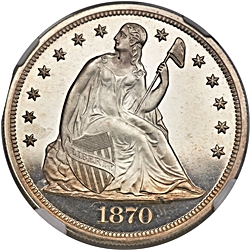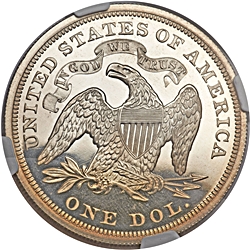 |
1870
 

|
 |
General Comments
|
| |||||||||||||||||||||
In proof, the finest known examples are PR67. PCGS has graded two at that level, with one designated as Cameo. NGC has graded three, two cameo and one ultra-cameo. At the PR66 level PCGS has graded eight coins, with one receiving a Cameo designation and two Deep Cameo. NGC has graded 16. Four of those were evaluated as cameo, one ultra-cameo. At the PR65 level PCGS has graded 36 examples while NGC has graded 27. Proof population statistics are as of September, 2022. 1870 is one of the most available years in proof.
1870 examples are often weakly struck. Several die marriages usually exhibit weak stars and sometimes weak hair detail. Reverses are usually sharp except for slight softness on the lower portions of the horizontal shield lines. High-grade business strikes are sometimes prooflike or semi-prooflike, but just as often frosty. We’ve seen four business strikes incorrectly slabbed as proofs by the major grading services. This doesn’t seem to be as common as it is for coins dated 1869. Many proofs show strike weakness on the eagle feathers. It’s a challenge to find one well-struck.
1870 Die Marriages
Note that OC-10 pairs obverse P1 with Reverse A in a business strike pairing, making it one of a small number of exceptions to our observation that proof dies were seldom used to strike business strikes.
In addition to the 10 known business strike die marriages we’ve discovered two re-marriages. Dies 3-A and 4-A were each paired twice during the year at different times. These re-marriages are noted in our discussion of the emission sequence. These are currently among a very small number of documented re-marriages in the Liberty Seated dollar series.
Three proof die pairs shared the same obverse die, our obverse P1. The first die marriage paired it with 1869 Reverse PA, now in its second year of use. The second die marriage also paired it with an 1869 reverse, Reverse 1869 PB. The use of this reverse in 1869 was discovered recently, well after the publication of the 1st Edition, so it was not known at that time that the die was transitional, and it was identified as 1870 Reverse PA. In this second edition I’ve changed the nomenclature to identify the die as 1869 Reverse PB to recognize it’s transitional use. Note that this die was also used to strike several patterns dated 1870 and 1871. A more notable usage was the striking of the 1863 WITH MOTTO fantasy pieces, Judd-345, Judd-346, and Judd-347.
The third 1869 proof die marriage paired Obverse P1 with Reverse 1866 PA, now in its fifth year of use. The third die marriage is rare, currently rated R5+.
The following table summarizes the known 1870 die marriages. Note that the two noted re-marriages were discovered in 2022, well after the publication of the first release of our book.
Click the links below to view the details of each die marriage.
Die Marriage |
Rarity |
Obverse Die |
Reverse Die |
Estimated Survivors |
| OC-1 | R5+ | 1 | A | 40 |
| OC-2 | R3 | 2 | A | 375 |
| OC-3 | R2 | 3 | A | 1200 |
| OC-3a | R5- | 3 | A | 80 |
| OC-4 | R4+ | 4 | A | 105 |
| OC-4a | R3+ | 4 | A | 265 |
| OC-5 | R3+ | 5 | A | 240 |
| OC-6 | R2 | 5 | B | 790 |
| OC-7 | R3+ | 6 | C | 225 |
| OC-8 | R6+ | 6 | A | 15 |
| OC-9 | R4- | 7 | A | 175 |
| OC-10 | R6+ | P1 | A | 15 |
| OC-P1 | R3- | P1 | 1869 PA | 460 |
| OC-P2 | R4+ | P1 | 1869 PB | 100 |
| OC-P3 | R5+ | P1 | 1866 PA | 40 |
1870 Business Strike Emission Sequence
Progressive die cracking allowed determination of the emission sequence for the numerous die marriages
which used Reverse A. The exceptions are OC-1. OC-2. And OC-8. All examples seen exhibit the same
reverse die state, so the placement relies on estimating the extent of reverse die polishing. There
is some uncertainty in the placement of OC-8 and OC-10 since we’ve seen only pictures of one mid-grade
example of each.
Emission Order |
Die Marriage |
Comments |
| 1 | OC-4 | All examples seen have a perfect reverse. |
| 2 | OC-1 | All examples seen have a lightly clashed reverse, but no die cracks. OC-1 was placed in the 2nd position by estimating the extent of reverse die polishing. |
| 3 | OC-2 | All examples seen have a lightly clashed reverse, but no die cracks. OC-2 was placed in the 3rd position by estimating the extent of reverse die polishing. |
| 4 | OC-8 | The only example seen has a lightly clashed reverse, but no die cracks. OC-8 was placed in the 4th position by estimating the extent of reverse die polishing. |
| 5 | OC-3 | Reverse A die cracks place OC-3 after OC-1, 2, and 8. |
| 6 | OC-9 | Progressive reverse A die cracks place OC-9 after OC-3. |
| 7 | OC-10 | Progressive reverse A die cracks place OC-10 after OC-9. |
| 8 | OC-4a | This re-marriage is identified by Reverse A die cracks that have advanced beyond those noted on OC-10. |
| 9 | OC-5 | Progressive reverse A die cracks place OC-5 after OC-4a. |
| 10 | OC-6 | Reductions in unfinished areas of the obverse die due to die polishing place OC-6 after OC-5. |
| 11 | OC-3a | OC-3a has only been seen exhibiting the latest die state of Reverse A. |
| 12 | OC-7 | Placement of OC-7 is arbitrary. We know only that it came after OC-8 due to obverse die wear. |
1870 Proof Emission Sequence
Die polishing allowed determination of the proof emission sequence,
although the differences are minute, so our results are open to interpretation.
Emission Order |
Die Marriage |
Comments |
| 1 | OC-P1 | |
| 2 | OC-P2 | Obverse P1 die polishing places OC-P2 after OC-P1 |
| 3 | OC-P3 | Obverse P1 die polishing places OC-P3 after OC-P2 |
1870 Quick Finder Chart
Attribution of 1870 die marriages is relatively easy, although lower grade coins may prove to be difficult.
Date positions are similar, but most obverses display other characteristics that distinguish them from
other dies for the year. The following table lists the keys for identifying each variety.
Die Marriage |
Obv Die |
Rev Die |
Right |
Keys |
| OC-1 | 1 | A | JL of RE | Obverse: Date is slightly low. 1 = 5-1.0. Reverse: A strong die line connects leaves 1 and 2. |
| OC-2 | 2 | A | RE | Obverse: Die lines and rust in gown left of pole base. Reverse: A strong die line connects leaves 1 and 2. |
| OC-3 | 3 | A | JR of C | Obverse: Small lump between legs, left of pole base. Reverse: A strong die line connects leaves 1 and 2. The reverse die is state b, c, or d. |
| OC-3a | 3 | A | JR of C | Obverse: The lump between legs is now huge. Reverse: A strong die line connects leaves 1 and 2. The reverse is state f. |
| OC-4 | 4 | A | B | Obverse: Lump at left of unfinished area under the chin. 1 = 4-3.5. Reverse: A strong die line connects leaves 1 and 2. The reverse die is state a. |
| OC-4a | 4 | A | B | Obverse: Lump at left of the unfinished area under the chin. 1 = 4-3.5. Reverse: A strong die line connects leaves 1 and 2. The reverse die is state f. |
| OC-5 | 5 | A | R QTR | Obverse: Date slightly low. Farthest left of any date for the year. 1 = 4-2.0. Reverse: A strong die line connects leaves 1 and 2. |
| OC-6 | 5 | B | R QTR | Obverse: Date slightly low. Farthest left of any date for the year. 1 = 4-2.0 Reverse: Die lines in motto - through US, along the left side of the shaft of the 2nd T in TRUST. |
| OC-7 | 6 | C | JR of C | Obverse: Lumps under chin. A large lump in gown just left of pole. Reverse: Curving die lines in motto - in first fold and off left side of R. |
| OC-8 | 6 | A | JR of C | Obverse: Lumps under chin. A large lump in gown just left of pole. Reverse: A strong die line connects leaves 1 and 2. |
| OC-9 | 7 | A | B | Obverse: Farthest right of any date for the year. 1 = 5-3.5. Reverse: A strong die line connects leaves 1 and 2. |
| OC-10 | P1 | A | LE | Obverse: A curved die line off the left end of the ribbon. Reverse: A strong die line connects leaves 1 and 2. |
| OC-P1 | P1 | 1869 PA | LE | Obverse: A curved die line off the left end of the ribbon. Reverse: Very minor doubled die. 80% finished around the leaves. |
| OC-P2 | P1 | 1869 PB | LE | Obverse: A curved die line off the left end of the ribbon. Reverse: Largely unfinished between the leaves. No doubling on IN in the motto. Minor doubling on the top of WE. Several tiny marks around TRU. |
| OC-P3 | P1 | 1866 PA | LE | Obverse: A curved die line off the left end of the ribbon. Reverse: Die line from top right corner of N through bottom of GOD. |
| Photo credits:
Obverse and reverse full photos: 1870 NGC PR67 Ultra Cameo, finest known proof, from the Heritage archives. |
